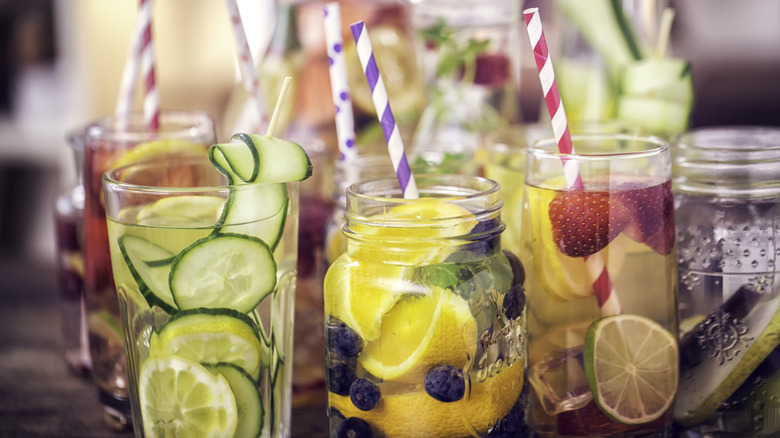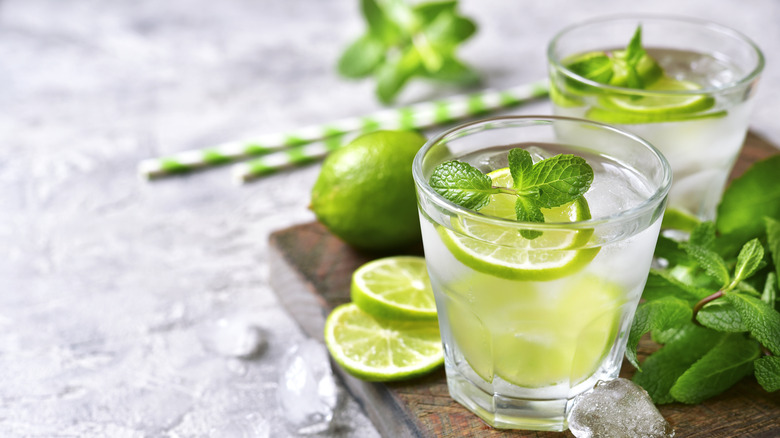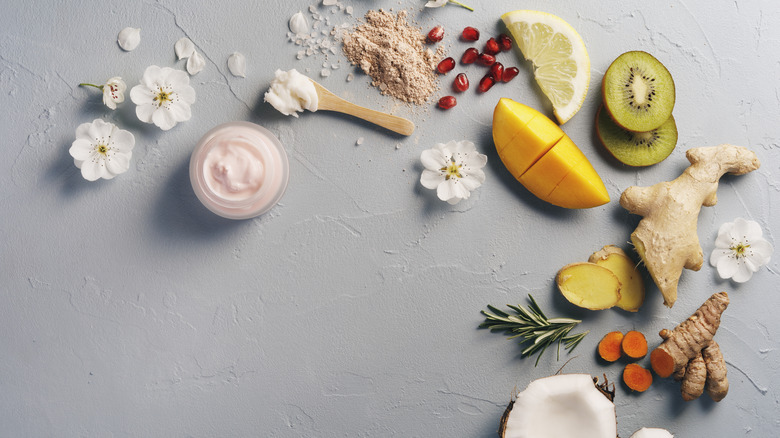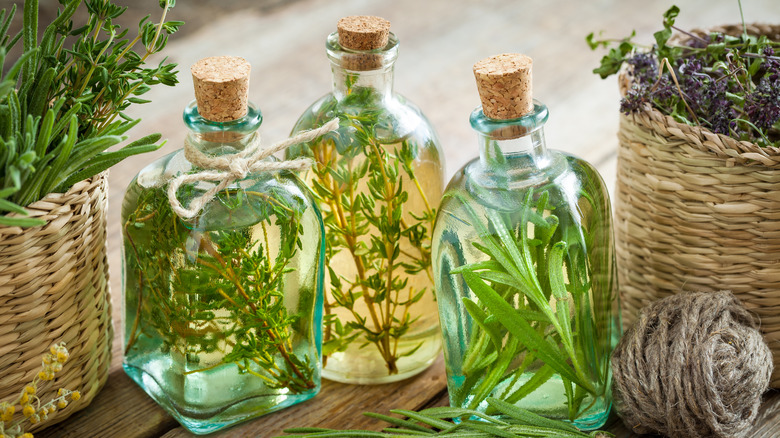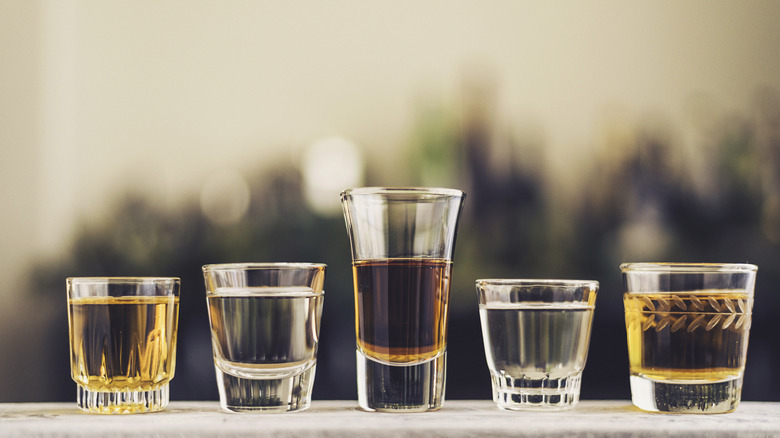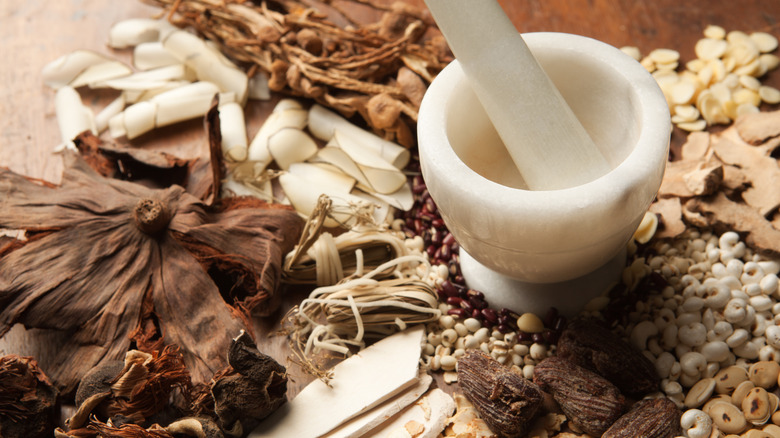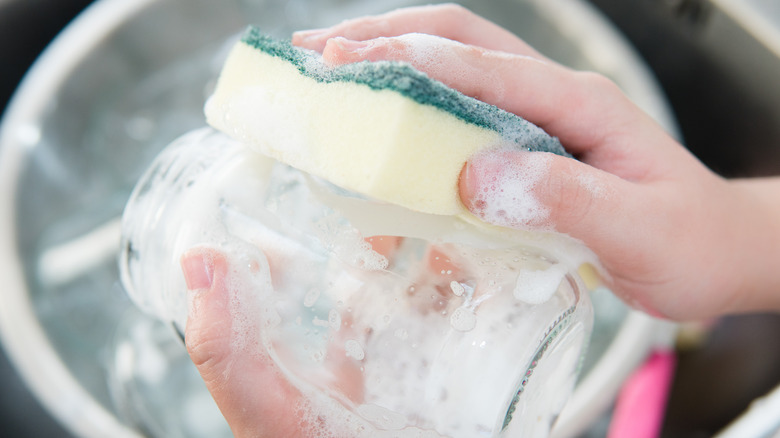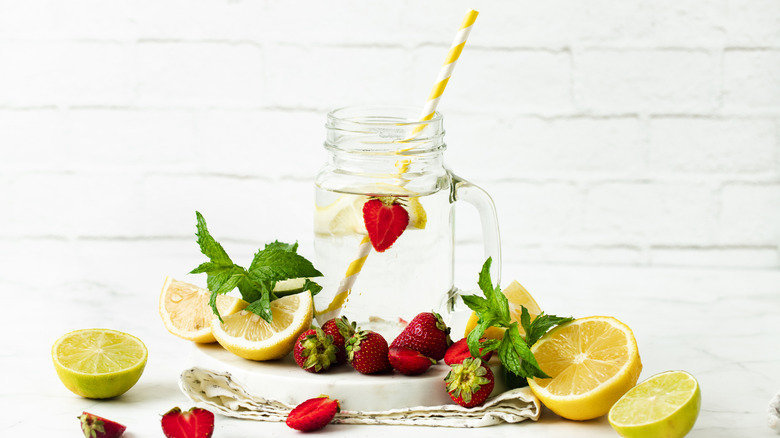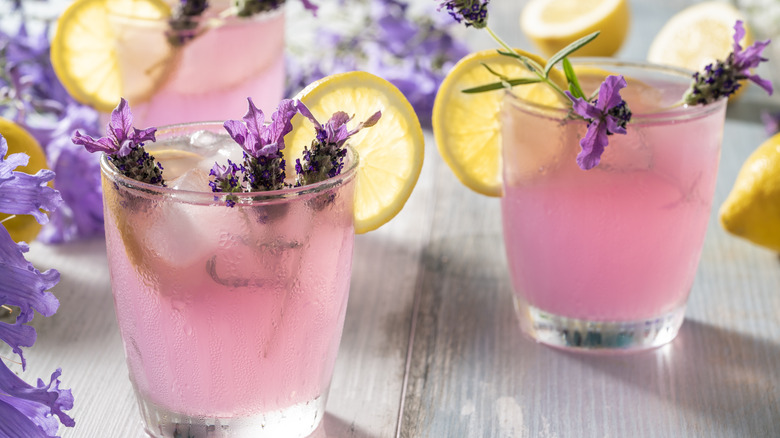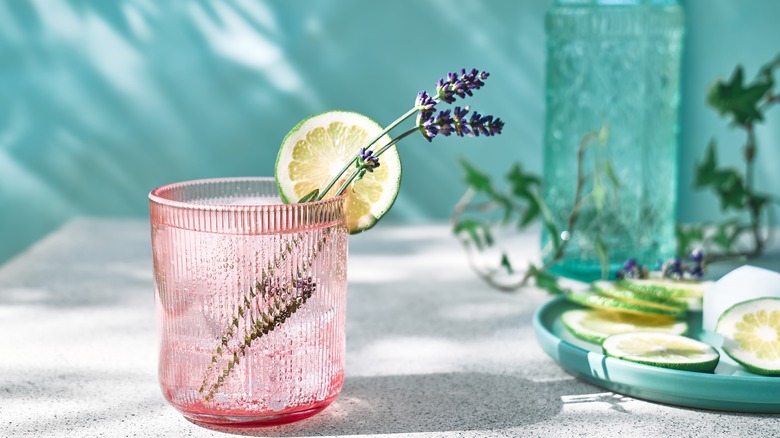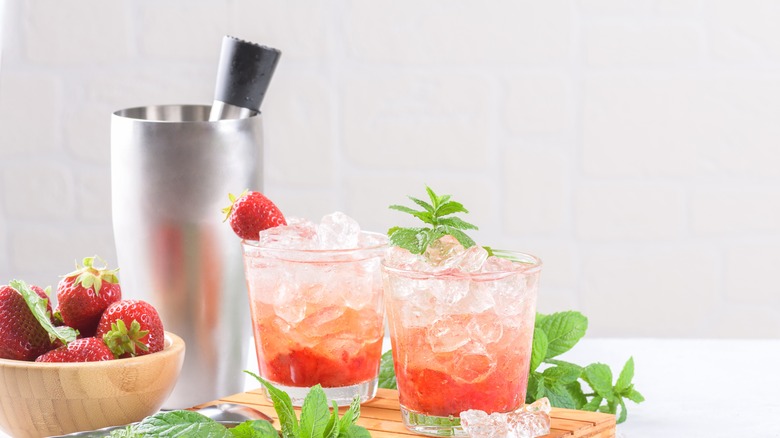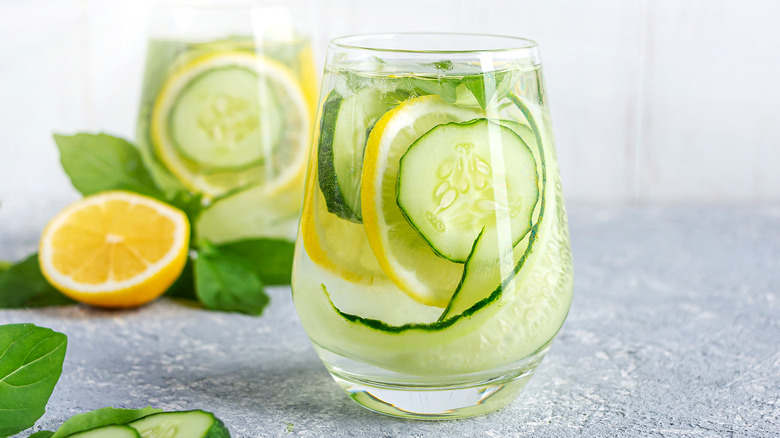Mistakes Everyone Makes When Infusing Alcohol
Infusing your own alcohol is the ultimate way to take your at-home mixology skills to the next level. Rather than just buying a bottle of alcohol and adding mixers to make simple cocktails and mixed drinks, you can create your own flavored alcohol with any delicious blend of ingredients that you like.
The concept of infusing alcohol is very simple. Infusing is the process of adding a flavorful ingredient, such as spices, fruit, and herbs, to a liquid (in this case, alcohol). After sealing and leaving the liquid to steep, the alcohol absorbs the flavors around it so that the base spirit is infused with the added flavors. The amount of time you leave the mixture to steep can vary from a day to several weeks, depending on the ingredients and the taste you're going for. Then, it's just a matter of straining the mixture to remove any particles and enjoying your smooth, flavorful alcoholic creation.
It sounds simple, and it is. However, there are many points in the infusion process where things can go wrong. A simple mistake can render what should be a delicious alcohol infusion undrinkable. Fortunately, we've consulted experts on the most common mistakes that occur while infusing alcohol and how to avoid them. By steering clear of those common errors, you can go forward with confidence and make the perfect alcohol infusions.
Using low-quality alcohol
The first step to making a good alcohol infusion is starting off with the right base. Using low-quality alcohol as your base ingredients will only lead to overall poor quality for the finished product. You may think that the botanicals, fruits, or spices you add to flavor the alcohol will mask the poor quality of the base spirit. However, this is not the case. Using low-quality or low-proof alcohol won't give you the final product you want.
Touching on this issue, Alex Mastin, CEO & founder of Home Grounds, told Mashed that using a "poor-quality or mismatched base spirit" is one of the biggest mistakes you can make. Mastin recommended that "Starting with a high-quality, neutral base spirit will help the flavors of the infusion be more pronounced or appealing." It's also important to keep the proof in mind. The higher the proof of the alcohol, the faster it will extract flavor from the infusion ingredients.
Professional chef and food blogger of Dinner then Dessert Sabrina Snyder also offered her expertise on picking suitable alcohol. She recommends choosing alcohol you enjoy the taste of since the infusion will not erase that base flavor. However, you don't have to break the bank on top-shelf alcohol. Snyder advised that mid-range alcohol will do just fine. Lastly, she added, "It's hard to infuse alcohol with naturally strong peaty or smoky flavors like scotch and mezcal," so you may want to opt for a base spirit with a more neutral flavor.
Steeping the ingredients for too long
Infusing alcohol is quite an easy process since most of it is done without hands-on work. After you add the infusion ingredients, seal them, and shake to combine, it's just a matter of leaving the airtight container in a cool place to let the base spirit soak up the flavor. But, perhaps because it's so simple, it's easy to get carried away and leave the mixture infusing for too long. While you want to give the infusion process enough time for the alcohol to absorb the flavor, leaving it for too long will ruin those amazing flavors.
Andrew Kuttow is a beer and drink blogger for Chainless Brewing who warned that leaving your infusion mixture to steep too long will result in "overpowering or bitter flavors." To avoid this, Kuttow recommends that you "monitor the infusion regularly and taste it to determine when it's reached the desired flavor intensity. The time can vary depending on the ingredients and the alcohol, so experimenting and taking notes can be helpful."
The ingredients you use and the proof of the alcohol will heavily impact how long you should leave the infusion steeping. Sabrina Snyder explained, "Some bolder ingredients like jalapeños and cloves only need about a day or two. Sweet, lighter tropical fruits like pineapple and mango can be steeped for up to two weeks, but you'll want to taste it occasionally to make sure the flavor isn't turning syrupy."
Using improper storage containers
While it may be tempting to pour your base spirit and flavor ingredients into whatever available container you have in your kitchen, you should take the time to find a sturdy, airtight container. Using a high-quality, airtight storage container is just as essential to a good infusion as the ingredients are. You want to add the infusion ingredients to a storage container that you can leave to sit in a cool place for days at a time without the contents being compromised.
Using containers that aren't airtight can lead to the ingredients going bad. You should also be wary of the material your container is made out of. Glass mason jars or another type of airtight glass containers are ideal since the alcohol can leech the flavor from metal or plastic containers, according to Alex Mastin. Addressing the same issue, drink expert Andrew Kuttow advised using clean glass containers and to "store the infusion in a cool, dark place, and consider refrigeration if the infusion contains perishable ingredients."
Choosing the wrong base spirit
Picking the wrong liquor for your base can ruin your alcohol infusion before you even start. As a general rule, you'll want to avoid any alcohol that has too strong of a flavor already. The more neutral the base spirit, the easier the infusion flavors can shine through. This is why vodka is often used for infusions. Vodka is almost flavorless, so it takes on the infusion beautifully. Other light spirits like gin, tequila, sake, and white rum are also common. When infusing dark liquors that already have a strong flavor of their own, you need to be even more mindful of the flavor ingredients you add and how to balance them well.
Sabrina Snyder advised thinking of the overall flavor profile when picking your base spirit. "Dark, bold liquors like rye and whiskey go great with strong flavors like warm spices, citrus, and smoky ingredients. Milder liquor like vodka and white rum let lighter flavors like berries, tropical fruit, and fresh herbs shine through," Snyder said. Keeping that in mind, you can choose your base spirit based on the infusion ingredients you want to add. While infusing alcohol can be a little experimental, it's good to have a basic flavor profile you're aiming for from the start.
Using mismatched ingredients
Infusing alcohol is a great time to have fun by adding your favorite flavors to create your dream cocktail blend. However, it is still important not to add too many flavors at once or try to blend ingredients that just don't go together. "While it's great to be creative, you still want to stick to some general rules when it comes to flavor combinations with the type of alcohol you are using," Sabrina Snyder said.
If you use mismatched ingredients, the flavors will just compete with each other and become muddled. To avoid this, Andrew Kuttow suggested starting with a couple of simple ingredients that you know go well together. If you're having a hard time choosing between flavors, you can always make a few small batches with different ingredients rather than trying to add them all to the same infusion. "As you become more experienced, you can experiment with more complex combinations," Kuttow said. "Always consider how the flavors will interact, and taste the infusion regularly to ensure a balanced profile."
Forgetting to properly wash equipment or ingredients
Just like it is essential to use the right kind of storage equipment, you also need to properly wash before adding ingredients. If you're using storage containers that have held other kinds of food or non-food items, the alcohol can absorb those remaining flavors, which will interfere with the taste of your drink. That's why you need to properly wash your glass container before adding the infusion ingredients. If you want to be extra safe, you can sterilize glass jars the same way you would for canning. To do this, place the jars right-side-up in a large pot. Add warm water to completely cover the jars with about an inch of water. Then, bring the water to a boil to sterilize. This is an extra step if you're concerned about what was previously in the containers. Typically, careful dish or hand washing will work fine.
Along with cleaning the containers, you'll also want to wash any fruit or botanicals you plan to add to the alcohol. This is especially important if you add citrus peels or other items that could have dirt or other contaminants on the surface. Andrew Kuttow warned that failing to sanitize can ruin the flavor and lead to contamination. "Thoroughly clean and sanitize all tools, containers, and surfaces that will come in contact with the alcohol or ingredients," Kuttow said. "This will help prevent any unwanted bacteria or flavors from entering the infusion."
Not properly straining the ingredients
According to Alex Mastin, "A smooth finish is the mark of a well-executed infusion." But, it's easy to miss the mark on this if you don't carefully strain the infused alcohol. Classic infusion ingredients like jalapeño, ginger, cardamom, and mint can add incredible flavor to the base spirit, but that doesn't mean you want whole pieces of them when you serve the drink. The infusion process allows the alcohol to absorb all that flavor so that you can sift out the mix-ins and enjoy the flavored liquor. Properly infused alcohol tastes delicious sipped on its own or added to a cocktail, and you certainly don't want that experience ruined by a stray spice or piece of sediment left in the blend.
"Failing to strain the infusion properly can result in sediment or unwanted particles in the final product," Mastin said. But, while this is an easy mistake to make, it's also an easy mistake to avoid. To ensure that you strain even small particles from the alcohol, simply pour the mixture through a fine sieve. Mastin suggests using a fine mesh strainer, coffee filter, or cheesecloth to get the perfect smooth finish. Discard the solid ingredients that you strained out, and serve the infused alcohol chilled.
Making too much
One of the critical philosophies when infusing alcohol is remembering to go a little at a time. This applies to how many flavors you add, how long you steep the alcohol, and how much alcohol you infuse at a time. The process of infusing spirits can be a bit experimental. The last thing you want to do is use up all your liquor on a flavor combination that you don't end up liking. Because of this, it's better to start with small batches. Instead of using a whole bottle of liquor, just fill a glass container with enough alcohol to make a couple of drinks or a few more, depending on how many people you're serving.
If you're hoping to have more alcohol than that, you can always make multiple batches with different herbs, botanicals, and fruit ingredients in each one. That way, if you don't like the way one mixture turns out, you won't have wasted a whole bottle of liquor on it and you'll still have the other batches to enjoy. This is also why it's a great idea to take notes when making alcohol infusions. Write down the ingredients, the amounts, and how you like the final results. The next time you're making an infusion, you can refer back to your notes to find an old favorite or tweak a recipe to make it closer to your liking.
Forgetting to taste test
It's easy to leave your alcohol infusion steeping for too long or too short of a time period if you aren't taste testing as you go. The amount of time you need to steep can vary greatly depending on the ingredients and how strong of a flavor you want. Some infusions take a day or two, while others may take far longer to get the flavors just right. Havana Club Brand Ambassador, Giovanny Gutierrez, recommended taste testing your infusion as often as every four to six hours while steeping. "[It] doesn't matter whether it's herbs, vegetables, spices, etc.," Gutierrez said, as this is always a critical step that you'll repeat multiple times. After testing the ingredients, he also urged writing down the results with the time you tested. "That way, you can pinpoint the exact a-ha moment of satisfaction."
Taste testing your infusion periodically also allows you to adjust the recipe and remove ingredients as you go if necessary. "Perhaps a spice like cinnamon is overpowering the other ingredients?," Sabrina Snyder suggested. "By taste testing every day or so, you can remove or add ingredients as needed until it tastes perfect and is ready for straining." Taste testing allows for trial and error as you go, rather than throwing out a whole batch that's steeped for too long or ending up with too weak of a mixture. It's the best way to get an alcohol infusion that you'll really love.
Using too many ingredients
Just like you can easily use mismatched ingredients that muddle the flavor profile, another common mistake is adding too many ingredients to the alcohol base. This can easily create too strong of a flavor, resulting in a bitter or sickly sweet alcohol infusion. Fortunately, if this process sounds overwhelming, there's a simple trick to remember. Instead of treating alcohol infusion like a guessing game, follow the golden ratio when adding flavoring ingredients to your liquor. The golden ratio is 1:3, using one part flavoring for every three parts liquor. So, for example, if you're infusing a cup of alcohol, you'll want 1/3 cup of flavoring ingredients for a robust but not overpowering taste.
On top of keeping the right ratio of alcohol to flavoring, Sabrina Snyder recommended only using a few ingredients. "Simple combinations of two to three flavors that all compliment each other and the alcohol are going to taste much better than a long list of ingredients ... Honestly, sometimes you only need one ingredient to make a delicious infused alcohol," Snyder said. With that in mind, start with a couple of tried-and-true ingredients, and remember to stick to a 1:3 ratio when it comes to the volume of ingredients.
Storing infused alcohol improperly
You can use the perfect base spirit, infusion ingredients, and ratio to get your alcohol infusion just right. But unfortunately, the recipe will still be unsatisfactory if you make a mistake in storing the infusion. Just as important as using a clean, airtight, glass storage container, you also need to make sure that you keep the container properly. It's essential to store the recipe well so that the ingredients don't go bad during the infusion time. Although you can safely keep most alcohol infusions at room temperature, it's best to put the recipe in a dry, cool place in your pantry. That way, you don't have to worry about the ingredients getting heated by the sun or other environmental factors. You can also store in the fridge if you want to keep the drink cool.
As long as the drink is properly stored, you shouldn't have to worry about the recipe going bad. To check that the infusion is safe to drink, look for clear liquid. Even after straining, there may be some small pieces of sediment from the infusion ingredients. This is normal and perfectly safe. However, if the liquid appears cloudy, that's a sign that something went bad in the mixture, and throwing the drink out is best.
